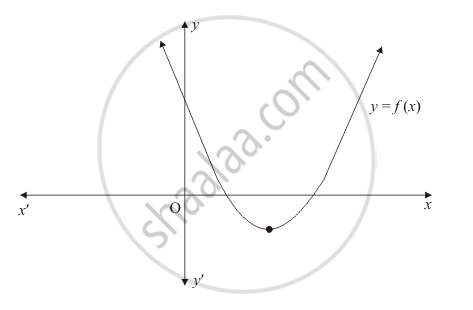Advertisements
Advertisements
प्रश्न
If one zero of the polynomial f(x) = (k2 + 4)x2 + 13x + 4k is reciprocal of the other, then k=
पर्याय
2
-2
1
-1
उत्तर
We are given f(x) = (k2 + 4)x2 + 13x + 4k then
`alpha + ß = - (text{coefficient of x})/(text{coefficient of } x^2)`
`= (-13)/(k^2+4)`
`alpha xxbeta = (\text{constat term})/(text{coefficient of} x^2)`
`= (4k)/(k^2+4)`
One root of the polynomial is reciprocal of the other. Then, we have
`alpha xxbeta`
`⇒ (4k)/(k^2+4)=1`
`⇒ k^2 - 4k +4 =0`
`⇒ (k -2)^2 =0`
`⇒ k =2`
Hence the correct choice is (a)
APPEARS IN
संबंधित प्रश्न
Classify the following polynomials as linear, quadratic, cubic and biquadratic polynomials
`7t^4+4t^3+3t-2`
Write the standard form of a quadratic polynomial with real coefficients.
The graph of the polynomial f(x) = ax2 + bx + c is as shown below (Fig. 2.19). Write the signs of 'a' and b2 − 4ac.

For what value of k, −4 is a zero of the polynomial x2 − x − (2k + 2)?
State whether the given algebraic expression are polynomial? Justify.
`2 - 5 sqrt x`
Which of the following is a polynomial?
Obtain all the zeroes of the polynomial 2x4 − 5x3 − 11x2 + 20x + 12 when 2 and − 2 are two zeroes of the above polynomial.
Find the quadratic polynomial, sum, and product of whose zeroes are −1 and −20 respectively. Also, find the zeroes of the polynomial so obtained.
An asana is a body posture, originally and still a general term for a sitting meditation pose, and later extended in hatha yoga and modern yoga as exercise, to any type of pose or position, adding reclining, standing, inverted, twisting, and balancing poses. In the figure, one can observe that poses can be related to representation of quadratic polynomial.


The graph of parabola opens downwards, if:
Determine the degree of the following polynomial:
–10
